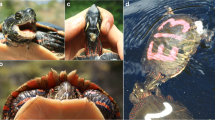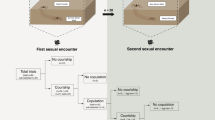Abstract
Although the sexes are united in hermaphrodites, conflict can still occur because the male and female functions have separate interests. We examined the evidence for conflict in the mating system of the terrestrial snail Cantareus aspersus (formerly Helix aspersa) where sharp, calcareous darts are ‘shot’ during courtship. We predicted that the use of the dart would either reflect or create conflict and this would be evident in either the courtship behavior or the transference of sperm. Previous studies demonstrated that the dart functions after sperm transfer to increase sperm survival. Using detailed observations of mating snails, we examined the factors that determine dart shooting order, the behavioral responses after being hit by a dart, the accuracy of dart shooting, and the allocation of sperm resources. We found that each dart was shot independently, and each animal appeared to be interested only in getting off the best possible shot, probably one that penetrates deeply near the genital pore. There is no evidence of mating conflict. Every snail transfers sperm to its partner, and the size of the donation does not depend on the success or failure of either snail’s dart shot. Although the receipt of a dart does not appear to cause harm, it may produce indirect costs due to the partial loss of control over fertilization. We conclude that mating in C. aspersus is a partnership in which independent actors demonstrate unconditional reciprocity during courtship and sperm transfer.


Similar content being viewed by others
References
Adamo SA, Chase R (1988) Courtship and copulation in the terrestrial snail Helix aspersa. Can J Zool 66:1446–1453
Anthes N, Michiels NK (2005) Do “sperm trading” simultaneous hermaphrodites always trade sperm? Behav Ecol 16:188–195
Balaban PM, Chase R (1990) Stimulation of mesocerebrum in Helix aspersa inhibits the neural network underlying avoidance behavior. J Comp Physiol A 166:421–427
Baminger H, Locher R, Baur A (2000) Incidence of dart shooting, sperm delivery, and sperm storage in natural populations of the simultaneously hermaphroditic land snail Arianta arbustorum. Can J Zool 78:1767–1774
Baur B, Locher R, Baur A (1998) Sperm allocation in simultaneously hermaphroditic land snail Arianta arbustorum. Anim Behav 56:839–845
Chapman T, Arnqvist G, Bangham J, Rowe L (2003) Sexual conflict. Trends Ecol Evol 18:41–47
Charnov EL (1979) Simultaneous hermaphroditism and sexual selection. Proc Natl Acad Sci USA 76:2480–2484
Chase R (2002) Behavior and its neural control in gastropod molluscs. Oxford University Press, New York
Chung DJD (1986) Initiation of growth of the first dart in Helix aspersa Müller. J Molluscan Stud 52:253–255
Chung DJD (1987) Courtship and dart shooting behavior of the land snail Helix aspersa. Veliger 30:24–39
Colegrave N, Ruxton GD (2003) Confidence intervals are a more useful complement to nonsignificant tests than are power calculations. Behav Ecol 14:446–447
Davison A, Wade CM, Mordan PB, Chiba S (2005) Sex and darts in slugs and snails. J Zool (in press)
Greeff JM, Michiels NK (1999) Sperm digestion and reciprocal sperm transfer can drive hermaphrodite sex allocation to equality. Am Nat 153:421–430
Hänggi C, Locher R, Baur B (2002) Intermating interval and number of sperm delivered in the simultaneously hermaphroditic land snail Arianta arbustorum (Pulmonata: Helicidae). Veliger 45:224–230
Koene JM, Chase R (1998) Changes in the reproductive system of the snail Helix aspersa caused by mucus from the love dart. J Exp Biol 201:2313–2319
Koene JM, Schulenburg H (2005) Shooting darts: co-evolution and counter-adaptation in hermaphroditic snails. BMC Evol Biol DOI 10.1186/1471-2148-5-25
Landolfa MA (2002) On the adaptive function of the love dart of Helix aspersa. Veliger 45:231–249
Landolfa MA, Green DM, Chase R (2001) Dart shooting influences paternal reproductive success in the snail Helix aspersa (Pulmonata, Stylommatophora). Behav Ecol 12:773–777
Leonard JL (1990) The hermaphrodite’s dilemma. J Theor Biol 147:361–372
Leonard JL (1992) The ‘love-dart’ in helicid snails: a gift of calcium or a firm commitment? J Theor Biol 159:513–521
Michiels NK (1998) Mating conflicts and sperm competition in simultaneous hermaphrodites. In: Birkhead TR, Møller AP (eds) Sperm competition and sexual selection. London, Academic, pp219–254
Michiels NK, Newman LJ (1998) Sex and violence in hermaphrodites. Nature 391:647
Pomiankowski A, Reguera P (2001) The point of love. Trends Ecol Evol 16:533–534
Rogers DW, Chase R (2001) Dart receipt promotes sperm storage in the garden snail Helix aspersa. Behav Ecol Sociobiol 50:122–127
Rogers DW, Chase R (2002) Determinants of paternity in the garden snail Helix aspersa. Behav Ecol Sociobiol 52:289–295
Vindelov LL, Christensen IJ, Nissen NI (1983) A detergent-trypsin method for the preparation of nuclei for flow cytometric DNA analysis. Cytometry 3:323–327
Acknowledgements
We thank Katrina Blanchard, Robert Hutcheson, Joris Koene and Heike Reise for their comments on the manuscript. Angus Davison kindly allowed us to see unpublished work. Funded by a grant to R. Chase and an Undergraduate Student Research Award to K. Vaga, both from the Natural Sciences and Engineering Research Council of Canada. This research complies with current laws in Canada.
Author information
Authors and Affiliations
Corresponding author
Additional information
Communicated by P.J. Moore
Rights and permissions
About this article
Cite this article
Chase, R., Vaga, K. Independence, not conflict, characterizes dart-shooting and sperm exchange in a hermaphroditic snail. Behav Ecol Sociobiol 59, 732–739 (2006). https://doi.org/10.1007/s00265-005-0103-y
Received:
Revised:
Accepted:
Published:
Issue Date:
DOI: https://doi.org/10.1007/s00265-005-0103-y




